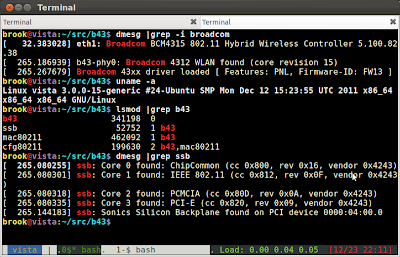
這是ELF的layout,所謂的Linking View是指以檔案呈現之ELF(左圖),而Execution View則是指被載入到RAM上執行的ELF(右圖)。ELF header會包含整個檔案的"road map",我們可以利用
readelf -h檢視elf header到底包含哪些東西?

由readelf -h可看出可看出ELF header包含了許多資訊,這些資訊都可以由定義在elf.h中的Elf32_Ehdr解讀出來。介紹ELF header之前,先介紹ELF的Data Types,這些資訊也都放置在elf.h檔中。

/* Standard ELF types. */
#include <stdint.h>
/* Type for a 16-bit quantity. */
typedef uint16_t Elf32_Half;
typedef uint16_t Elf64_Half;
/* Types for signed and unsigned 32-bit quantities. */
typedef uint32_t Elf32_Word;
typedef int32_t Elf32_Sword;
typedef uint32_t Elf64_Word;
typedef int32_t Elf64_Sword;
/* Types for signed and unsigned 64-bit quantities. */
typedef uint64_t Elf32_Xword;
typedef int64_t Elf32_Sxword;
typedef uint64_t Elf64_Xword;
typedef int64_t Elf64_Sxword;
/* Type of addresses. */
typedef uint32_t Elf32_Addr;
typedef uint64_t Elf64_Addr;
/* Type of file offsets. */
typedef uint32_t Elf32_Off;
typedef uint64_t Elf64_Off;
/* Type for section indices, which are 16-bit quantities. */
typedef uint16_t Elf32_Section;
typedef uint16_t Elf64_Section;
/* Type for version symbol information. */
typedef Elf32_Half Elf32_Versym;
typedef Elf64_Half Elf64_Versym;
Elf32和Elf64的data type只有在off和addr這兩種type的資料長度有不同,其餘都相同。您可以在下表中發現Elf32_Ehdr和Elf64_Ehdr的member資料長度只有差e_entry、e_phoff和e_shoff會不相同,其餘都相同,所以,Elf64_Ehdr比Elf32_Ehdr多了12byte。
ELF header如下
/* The ELF file header. This appears at the start of every ELF file. */
#define EI_NIDENT (16)
typedef struct
{
unsigned char e_ident[EI_NIDENT]; /* Magic number and other info */
Elf32_Half e_type; /* Object file type */
Elf32_Half e_machine; /* Architecture */
Elf32_Word e_version; /* Object file version */
Elf32_Addr e_entry; /* Entry point virtual address */
Elf32_Off e_phoff; /* Program header table file offset */
Elf32_Off e_shoff; /* Section header table file offset */
Elf32_Word e_flags; /* Processor-specific flags */
Elf32_Half e_ehsize; /* ELF header size in bytes */
Elf32_Half e_phentsize; /* Program header table entry size */
Elf32_Half e_phnum; /* Program header table entry count */
Elf32_Half e_shentsize; /* Section header table entry size */
Elf32_Half e_shnum; /* Section header table entry count */
Elf32_Half e_shstrndx; /* Section header string table index */
} Elf32_Ehdr;
typedef struct
{
unsigned char e_ident[EI_NIDENT]; /* Magic number and other info */
Elf64_Half e_type; /* Object file type */
Elf64_Half e_machine; /* Architecture */
Elf64_Word e_version; /* Object file version */
Elf64_Addr e_entry; /* Entry point virtual address */
Elf64_Off e_phoff; /* Program header table file offset */
Elf64_Off e_shoff; /* Section header table file offset */
Elf64_Word e_flags; /* Processor-specific flags */
Elf64_Half e_ehsize; /* ELF header size in bytes */
Elf64_Half e_phentsize; /* Program header table entry size */
Elf64_Half e_phnum; /* Program header table entry count */
Elf64_Half e_shentsize; /* Section header table entry size */
Elf64_Half e_shnum; /* Section header table entry count */
Elf64_Half e_shstrndx; /* Section header string table index */
} Elf64_Ehdr;
/* Fields in the e_ident array. The EI_* macros are indices into the
* array. The macros under each EI_* macro are the values the byte
* may have. */
#define EI_MAG0 0 /* File identification byte 0 index */
#define ELFMAG0 0x7f /* Magic number byte 0 */
#define EI_MAG1 1 /* File identification byte 1 index */
#define ELFMAG1 'E' /* Magic number byte 1 */
#define EI_MAG2 2 /* File identification byte 2 index */
#define ELFMAG2 'L' /* Magic number byte 2 */
#define EI_MAG3 3 /* File identification byte 3 index */
#define ELFMAG3 'F' /* Magic number byte 3 */
/* Conglomeration of the identification bytes, for easy testing as a word. */
#define ELFMAG "\177ELF"
#define SELFMAG 4
#define EI_CLASS 4 /* File class byte index */
#define ELFCLASSNONE 0 /* Invalid class */
#define ELFCLASS32 1 /* 32-bit objects */
#define ELFCLASS64 2 /* 64-bit objects */
#define ELFCLASSNUM 3
#define EI_DATA 5 /* Data encoding byte index */
#define ELFDATANONE 0 /* Invalid data encoding */
#define ELFDATA2LSB 1 /* 2's complement, little endian */
#define ELFDATA2MSB 2 /* 2's complement, big endian */
#define ELFDATANUM 3
#define EI_VERSION 6 /* File version byte index */
/* Value must be EV_CURRENT */
#define EI_OSABI 7 /* OS ABI identification */
#define ELFOSABI_NONE 0 /* UNIX System V ABI */
#define ELFOSABI_SYSV 0 /* Alias. */
#define ELFOSABI_HPUX 1 /* HP-UX */
#define ELFOSABI_NETBSD 2 /* NetBSD. */
#define ELFOSABI_LINUX 3 /* Linux. */
#define ELFOSABI_SOLARIS 6 /* Sun Solaris. */
#define ELFOSABI_AIX 7 /* IBM AIX. */
#define ELFOSABI_IRIX 8 /* SGI Irix. */
#define ELFOSABI_FREEBSD 9 /* FreeBSD. */
#define ELFOSABI_TRU64 10 /* Compaq TRU64 UNIX. */
#define ELFOSABI_MODESTO 11 /* Novell Modesto. */
#define ELFOSABI_OPENBSD 12 /* OpenBSD. */
#define ELFOSABI_ARM_AEABI 64 /* ARM EABI */
#define ELFOSABI_ARM 97 /* ARM */
#define ELFOSABI_STANDALONE 255 /* Standalone (embedded) application */
#define EI_ABIVERSION 8 /* ABI version */
#define EI_PAD 9 /* Byte index of padding bytes */
資料結構大致介紹完畢,接著就可以透過實做readelf -h的程式來了解ELF header了,首先,所有的ELF開頭都會有16 bytes的ELF Identification,也是本章節所要介紹的部份。
所有的ELF前面4byte為magic number,其內容為{0x7f, 'E', 'L', 'F'},用以判斷是否為ELF檔。

static int elf_header(int fd)
{
int sz;
unsigned char e_ident[EI_NIDENT];
sz = read(fd, e_ident, sizeof(e_ident));
if (sz < sizeof(e_ident)) {
fprintf(stderr, "invalid elf file\n");
return -1;
}
// 判斷是否為ELF檔
if (memcmp(ELFMAG, e_ident, SELFMAG)) {
fprintf(stderr, "invalid elf file\n");
return -1;
}
elf_header_magic(e_ident);
}
/**
* 印出ident(前面16byte)
*/
static int elf_header_magic(unsigned char *c)
{
int i;
printf("%-10s", "Magic: ");
for (i = 0; i < EI_NIDENT; i++) {
printf("%02X ", c[i]);
}
printf("\n");
return 0;
}
EI_CLASS這個byte是用來判斷是32-bit或是64-bit的ELF檔,根據不同的Class就要選擇使用Elf32_Ehdr或是Elf64_Ehdr判讀後面的資料。

/**
* 判斷是32-bit/64-bit architectures.
*/
static int elf_header_class(unsigned char c)
{
printf("%-36s", "Class: ");
switch(c) {
case ELFCLASSNONE:
fprintf(stderr, "Invalid class\n");
return -1;
case ELFCLASS32:
printf("32-bit object\n");
break;
case ELFCLASS64:
printf("64-bit object\n");
break;
default:
fprintf(stderr, "unknow class\n");
return -1;
}
return 0;
}
EI_DATA這個byte是用來判斷ELF檔是LSB(Little-endian)還是MSB(Big-endian)。
/**
* 判斷ELF檔是LSB(Little-endian)還是MSB(Big-endian)
*/
static int elf_header_data(unsigned char c)
{
printf("%-36s", "Data: ");
switch(c) {
case ELFDATANONE:
fprintf(stderr, "Invalid data encoding\n");
return -1;
case ELFDATA2LSB:
printf("2's complement, little endian\n");
break;
case ELFDATA2MSB:
printf("2's complement, big endian\n");
break;
default:
fprintf(stderr, "unknow data\n");
return -1;
}
return 0;
}
EI_VERSION這個byte是指出這個ELF檔的ELF header的版本是多少?目前這個值必須是EV_CURRENT。
static int elf_header_version(unsigned char c)
{
printf("%-36s", "Version: ");
switch(c) {
case EV_CURRENT:
printf("Current version");
break;
default:
case EV_NONE:
printf("Invalid ELF version");
break;
}
printf("(%d)\n", c);
return 0;
}
EI_OSABI這個byte是指出這個ELF檔會在那個OS上運行。
static int elf_header_osabi(unsigned char c)
{
printf("%-36s", "OS/ABI: ");
switch(c) {
case ELFOSABI_SYSV:
printf("UNIX System V ABI");
break;
case ELFOSABI_HPUX:
printf("HP-UX");
break;
case ELFOSABI_NETBSD:
printf("NetBSD.");
break;
case ELFOSABI_LINUX:
printf("Linux.");
break;
case ELFOSABI_SOLARIS:
printf("Sun Solaris.");
break;
case ELFOSABI_AIX:
printf("IBM AIX.");
break;
case ELFOSABI_IRIX:
printf("SGI Irix.");
break;
case ELFOSABI_FREEBSD:
printf("FreeBSD.");
break;
case ELFOSABI_TRU64:
printf("Compaq TRU64 UNIX.");
break;
case ELFOSABI_MODESTO:
printf("Novell Modesto.");
break;
case ELFOSABI_OPENBSD:
printf("OpenBSD.");
break;
case ELFOSABI_ARM_AEABI:
printf("ARM EABI");
break;
case ELFOSABI_ARM:
printf("ARM");
break;
case ELFOSABI_STANDALONE:
printf("Standalone (embedded) application");
break;
default:
fprintf(stderr, "unknow osabi\n");
return -1;
}
printf("(%d)\n", c);
return 0;
}
EI_ABIVERSION這個byte是指出這個ELF檔會在那個API版本上運行。一個OS上可能有多個ABI的版本在運行的版本在運行,如SYSV至少就有SVR、Solaris、SCO等ABI。0代表不指定(unspecified)。
static int elf_header_abi_version(unsigned char c)
{
printf("%-36s%d\n", "ABI Version: ", c);
return 0;
}
EI_PAD這個byte之後的都是padding。

到目前為止,僅有解釋ELF header中的e_ident,剩下的部份會在後面繼續探討與研究。







































